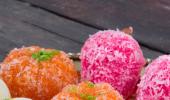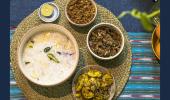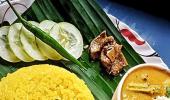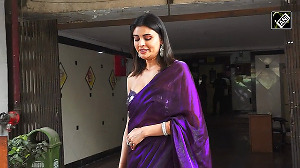
Odia desserts have flourished in Puri under the patronage of the Jagannath temple.
The temple was built in honour of Lord Jagannath, a mighty avatar of Vishnu, by King Indradyumna of Avanti, says temple annals. Anantavarman Chodaganga of the Eastern Ganga dynasty rebuilt it in the 11th century.

During the monsoon every year the famous chariot festival, the Jagannath Temple Rath Yatra, is celebrated over nine days.

A procession of astoundingly large and vibrant-looking chariots, bearing Lord Jagannath and his two siblings from the famous shrine, are pulled by hordes of devotees to their 'summer cottage', the Gundicha temple, about 2 km away, over a period of 24 hours. The phenomenon provides the English language with the word juggernaut, which means a massive advancing force.

Music, horses, royalty, plenty of colour and happy chaos are a sideshow to this unmissable full-moon event, which is repeated some eight-nine days later when the Jagannath family returns home from their 'vacation', stopping to see their aunt at Mausi Maa mandir, on the way back, who will feed them their favourite Poda Pitha.

Odisha's most famous temple has crucially fostered regional cooking styles and preserved local food traditions. Shristi Sahoo's recipe for Odia Malpua with Rabdi -- a special festival prasad offering to Lord Jagannath, as part of the 56-item Chappan Bhoga -- combines the deep-fried, slightly crispy malpuas with a rich and creamy rabdi, creating a delightful, sweet treat.

Odia Malpua With Rabdi
Serves: 5-6
Ingredients
For the malpuas:
- 1 cup maida or all-purpose flour
- ¼ cup suji or semolina
- ¼ cup sugar
- 1 cup full-cream milk (approximately, may need more)
- ½ tsp elaichi or cardamom powder
- ¼ tsp saunf or fennel seeds, lightly crushed, optional
- 2 tbsp powder, optional, for softer malpuas
- Ghee or oil, for frying
- Chopped pistachios, almonds, for garnish, optional
For the chashni or sugar syrup:
- 1 cup sugar
- ½ cup water
- ¼ tsp elaichi or cardamom powder
- Few strands kesar or saffron, soaked in 1 tbps warm milk
For the rabdi:
- 2 cups full-cream milk
- ¼ cup sugar or to taste
- ¼ tsp elaichi or cardamom powder
- Few strands kesar or saffron
- 1 tbsp milk powder mixed with 2 tbsp warm milk, optional, for quicker thickening
- 1 tbsp chopped almonds and pistachios, for garnish
Method
For the chashni or sugr syrup:
- In a saucepan, combine the sugar and the water and warm over medium heat, stirring until the sugar dissolves.
Bring to a boil and let it simmer for 5-7 minutes or until the syrup becomes slightly sticky. - A one-string consistency is usually preferred, but for malpua, a slightly less thick, sticky syrup also works well (please see the note below).
Add the cardamom powder, saffron.
Mix well, keep aside, keeping it warm if possible.
For the malpuas:
- In a mixing bowl, combine the all-purpose flour, semolina, sugar, cardamom powder, crushed fennel seeds, milk powder.
Gradually add the milk, mixing continuously to form a smooth, lump-free batter.
The consistency should be such that it flows easily but is not too thin and pourable with a ladle. - Cover the batter and let it rest for at least 30 minutes to an hour; this allows the semolina to absorb the liquid and the batter to become smooth.
For the rabdi:
- In a heavy-bottomed saucepan, bring the milk to a boil over medium heat.
Once boiling, reduce the heat to low and simmer, stirring occasionally to prevent sticking.
As the milk simmers, a layer of malai or cream will form on top.
Gently push it to the sides of the pan.
Continue to simmer the milk until it reduces to about 1/3 of its original volume.
This process will take some time.
Add the sugar, cardamom powder and stir until the sugar dissolves.
Now add the milk powder mixture, if using, to the simmering milk and stir continuously to avoid lumps.
Add saffron strands.
Scrape the cream from the sides of the saucepan and mix it back into the thickened milk.
Continue to simmer for another 2-3 minutes until the rabdi reaches a thick, custard-like consistency.
Take off heat, let it cool slightly, garnish with the chopped almonds, pistachios.
For frying the malpuas:
- Heat a little ghee or oil in a frying pan or skillet over medium heat; the ghee should be hot but not smoking.
Pour a ladleful of the batter into the hot ghee.
The malpua will spread out slightly.
Fry over medium-low heat until golden brown and crisp on both sides.
Adjust the heat as needed to ensure they cook evenly without burning.
Once cooked, drain the malpua from the pan with a slotted ladle or jharia, to remove excess ghee. - Repeat for the rest of the batter.
- Immediately immerse the hot malpuas in the warm sugar syrup for a few minutes, allowing them to soak up the sweetness.
Assembly:
- Take the soaked malpuas out of the syrup and arrange on a serving plate.
Spoon the prepared rabdi generously over the malpuas. - Garnish with extra chopped nuts if preferred.
- Serve warm or slightly chilled.
Editor's Note: A one-thread or one-string syrup is sugar syrup viscous enough to pass the one-thread test.
It is important to keep testing for consistency while the sugar syrup is boiling.
The test for this is: Dip a spatula, preferably wooden, into the boiling sugar syrup and take out.
Some syrup would have coated the spatula.
Let it cool slightly.
Touch the cooled syrup with your forefinger. Some syrup will come onto your finger.
Touch that with your thumb and separate thumb from forefinger.
When one little continuous delicate thread is formed by the syrup, when the coated forefinger is pulled away from your thumb, you have one-thread consistency sugar syrup.










